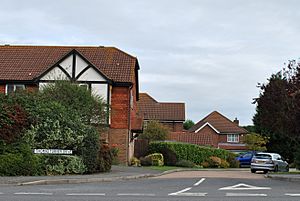Thomas Turner (diarist) facts for kids
Quick facts for kids
Thomas Turner
|
|
|---|---|
| Born | 9 June 1729 |
| Died | 6 February 1793 (aged 63) |
| Resting place | East Hoathly church |
| Occupation | Shopkeeper |
| Known for | Diary |
| Spouse(s) | Margaret 'Peggy' Slater (15 October 1753 – 23 June 1761) Mary Hicks (19 June 1765 – 6 February 1793) |
| Children | Peter (1754–1755) Margaret (1766–1791) Peter (1768–1786) Philip (1769–1829) Frederick (1771–1774) Michael (1773–1810) Frederick (b. & d. 1775) Frederick (b. & d. 1776) |
Thomas Turner (born June 9, 1729 – died February 6, 1793) was a shopkeeper in a village called East Hoathly in Sussex, England. He became famous much later because of a diary he kept for many years. His diary gives us a peek into what life was like in England during the 1700s.
Contents
Thomas Turner's Early Life
Thomas Turner was born in a place called Groombridge in Kent. When he was about six years old, his family moved to Framfield, where his father opened a shop. We don't know much about his school days. However, he wrote very clearly and was good at math. He also seemed interested in many different subjects. This suggests he had a good education for his time.
By the time he was 21, in 1750, Thomas had opened his own shop in East Hoathly. On October 15, 1753, he married his first wife, Margaret Slater, who was often called Peggy. They had one son named Peter, who was born in August 1754. Sadly, Peter passed away when he was just five months old. Thomas wrote in his diary about how sad he was to lose his little boy.
Thomas's Diary: A Look at Daily Life
Thomas Turner kept a diary for eleven years, starting in February 1754. His diary was more than just a place to write down his feelings. He used it to keep track of his money, record legal agreements, and think about his religious beliefs. It also described his everyday life, including his joys and challenges. He sometimes wrote about feeling sad when his marriage wasn't going as he hoped.
Thomas was a very important person in the East Hoathly community. Besides running his shop, he had many other jobs. He worked as an undertaker, a schoolteacher, and a surveyor (someone who measures land). He also helped manage money for the poor people in the village. He often helped others write important documents like wills and manage their accounts. Thomas regularly attended village meetings and sometimes visited Halland House, a large estate nearby.
What Thomas Enjoyed
Thomas loved to read! He read many different kinds of books, not just religious ones. He enjoyed plays by William Shakespeare and writings by famous thinkers like John Locke. He also read newspapers, magazines, and funny storybooks. His interests included caring for horses, politics, and learning about travel. Sometimes he read by himself, but often he would read books aloud with his wife or his friends. He also liked to socialize and play Cricket.
About the Diary Itself
The complete diary of Thomas Turner has never been fully printed as a book. A scholar named David Vaisey published a version that includes about one-third of the original diary. This book also has a family tree, short stories about the people in the diary, and a list of all the books Thomas mentioned reading. Some parts of his diary were printed in a magazine in 1859. Today, you can read these older parts online for free. The original diary is very long, with 111 separate books, and it is kept safe at Yale University in the United States.
Thomas Turner's Later Years
Thomas stopped writing in his diary a few weeks after he married his second wife, Mary Hicks, on June 19, 1765. His last diary entry, from July 31, said he was starting to feel settled and happy with his choice.
In the years after his second marriage, Thomas lived a comfortable life. He was able to buy his shop and also purchased land. He even bought the main public house (like a pub or inn) in East Hoathly. Thomas and Mary had seven children together, one girl and six boys. Sadly, only three of their children lived to be older than twenty years old.
Thomas Turner passed away on February 6, 1793. He was buried in the churchyard at East Hoathly. His gravestone is near the church, close to the grave of his son Philip. There is also a gravestone for two of his other sons, Peter and Frederick, in the same spot. Today, a special plaque marks his old house in East Hoathly.
Images for kids





